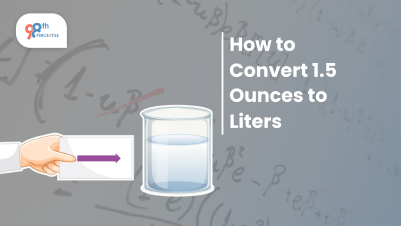Navigating the liquid world of ounces and liters may be like decoding a hidden code. Fear not, culinary explorers! This article will help you decode, revealing the mysteries of liquid measurement conversion and equipping you to take on any culinary task.
Start Your Child's Math Journey Now!
The Conversion Tactic
At the heart of every conversion is a basic constant, the Rosetta Stone of measurement translation. The constant for converting ounces to liters is 0.0296. This mystical number denotes that one US fluid ounce is equal to 0.0296 liters. Remember that this pertains to US fluid ounces, not imperial ounces, which are predominantly used in the United Kingdom.
The Conversion Formula
Now that you have the key, let us unlock the conversion procedure.
1. Identify the measurement. Locate the quantity you wish to convert and ensure it is in US fluid ounces.
2. Multiply by the conversion factor. Take the amount of ounces and multiply it by 0.0296.
3. Behold! You're finished: Voila! The final value is your comparable volume in liters.
From Recipes to Reality
Let's put our newfound knowledge to the test with some real-world scenarios:
Medium-Level Challenges
- Recipe Adjustment: You're whipping up a batch of cookies. The recipe calls for 8 ounces of milk, but you only have a measuring cup with liters. How much milk do you need?
Solution: 8 ounces * 0.0296 liters/ounce = 0.237 liters - Cocktail Creation: You're mixing a delicious cocktail requiring 2 ounces of vodka and 3 ounces of orange juice. What's the total volume in liters?
Solution: (2 ounces + 3 ounces) * 0.0296 liters/ounce = 0.148 liters
Complex-Level Challenges:
- Pancake Perfection: You're feeding a hungry crowd and need 12 cups of pancake batter. Each cup requires 4 ounces of milk. How many liters of milk do you need?
Solution: 12 cups * 4 ounces/cup * 0.0296 liters/ounce = 1.417 liters - Brewing Bliss: Your coffee maker requires 16 ounces of water for a full pot. You're brewing two pots. How many liters of water do you need?
Solution: 2 pots * 16 ounces/pot * 0.0296 liters/ounce = 0.948 liters - Scaling Up: Your favorite recipe uses 10 ounces of flour, and you're doubling the batch. How many liters of flour do you need?
Solution: 10 ounces * 2 * 0.0296 liters/ounce = 0.592 liters
Beyond the Kitchen Walls:
Our ability to convert between ounces and liters extends far beyond the kitchen, proving its versatility in various everyday situations:
- Medicine Measurement: Your child's medication requires 2.5 milliliters, but your syringe is marked in ounces. How much medication should you administer?
Solution: 2.5 milliliters * 0.0338 ounces/milliliter = 0.0845 ounces - Car Maintenance: Your car manual recommends 32 ounces of engine oil for each oil change. You accidentally bought a 3-liter bottle of oil. Is that enough?
Solution: 3 liters * 33.814 ounces/liter = 101.44 ounces - Gardening Guide: Your plant fertilizer requires 2 milliliters of concentrated solution per liter of water. You have 4 ounces of water but only a measuring cup marked in liters. How much concentrated solution do you need?
Solution: 4 ounces * 0.0338 ounces/milliliter * 2 milliliters/liter = 0.02704 liters - Science Experiment: Your experiment requires 1.5 ounces of a salt solution, but you only have a graduated cylinder marked in milliliters. How much solution do you need?
Solution: 1.5 ounces * 29.5735 milliliters/ounce = 44.36 milliliters - DIY Project: You're creating a homemade cleaning solution that requires 4 ounces of vinegar and 12 ounces of water. You only have measuring cups marked in liters. How much of each ingredient do you need?
Solution: 4 ounces * 0.0296 liters/ounce = 0.1184 litres
Book FREE Math Trial Classes Now!
By understanding these conversion factors and following the step-by-step instructions, you'll be able to comfortably switch between ounces and liters in a variety of real-world settings, assuring accurate liquid measures. Practice these conversions to improve your skills and speed up your job in culinary, chemistry, and other fields.

 Students/Staff
Students/Staff Parents
Parents ElevatEd
ElevatEd



-Nov-18-2025-03-57-47-3267-AM.png?width=360&length=360&name=401x226%20(6)-Nov-18-2025-03-57-47-3267-AM.png)



-Jul-22-2025-03-16-52-8797-AM.png?width=360&length=360&name=401x226%20(6)-Jul-22-2025-03-16-52-8797-AM.png)






